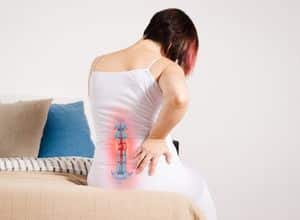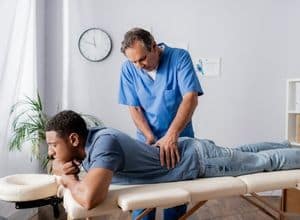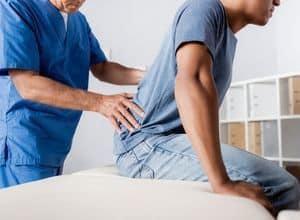If you’re looking for ways to treat herniated disc pain, you’ve come to the right place. Herniated discs happen when a disc cushioning your vertebrae in the spine becomes injured. This kind of degenerative disc disease puts strain on nearby nerves and the spinal cord, causing pain.
Description of a Herniated Disc
A herniated disc happens when the softer inner section of the disc’s nucleus presses through a fracture in the outer annulus. If the rupture compresses a nerve, symptoms may follow. Since this spine-related issue can be extremely painful, in addition to causing varying degrees of numbness or loss of strength, many sufferers seek treatment from a chiropractor. A herniated disc is also called a burst disc or a slipped disc.
Herniated Disc Symptoms
A herniated or bulging disc may occur suddenly as a result of an accident or strenuous activity, although discs usually herniate slowly and cause discomfort to build up. The pain and symptoms normally grow more obvious and eventually severe over time, which is why patients decide to seek ways to treat herniated disc pain.

A herniated or bulging disc may cause the following symptoms:
- Tingling sensations in the legs
- Muscle fatigue
- Numbness in the limbs
- Changes in bowel or bladder function
- Pain radiating from the limbs
- Neck ache while moving the neck
- Sciatica
- Low Back Ache
- Moving or stretching is difficult
Symptoms will, of course, vary depending on where the herniated disc is located in the spine. If you have back pain or discomfort in one area that has created radiating pain, numbness, and tingling, your condition might be caused by a ruptured or bulging disc.
Why Does This Occur?
Herniated discs might be caused by many factors, including accidents and inappropriate movement, as well as too much stress from weight or bad posture. Because of an injury or weakness, the inner section of the spinal disc might push through and protrude through the outer ring.
While a herniated disc may be caused by a single reason, such as a quick movement, the herniation is more likely to develop over time as a result of various stresses. Inflammation, numbness, nerve pain, and other symptoms compound and exacerbate the illness.
What Factors Influence Herniated Disc Pain?
Herniated discs and the discomfort involved occur for a number of causes. For example, if you have blunt force trauma to the spine, a disc may herniate. It might also be caused by lifting something or leaning over. Overall, any excessive pressure on the spine increases the probability that it may herniate.
Here are a few more ways that herniated disc discomfort might worsen:
Sleeping
Morning herniated disc and sciatica symptoms are often the worst. This is because while the disc is not bearing weight, it collects fluid in the spine overnight. When the disc collects fluid, it expands and strains the pain-sensitive disc fibers, causing discomfort.
Sitting
Sitting will also aggravate disc discomfort. Because sitting puts additional strain on the lumbar discs and damaged tissues, it causes increased discomfort. Disc sufferers dislike sitting or driving for extended periods and would rather be active since it makes them feel better.

Sitting might put up to three times more pressure on your spinal discs than standing. Pressure builds up on your spinal discs, particularly if they are herniated. Because the disc and membrane are already injured, the pressure is excruciating.
Lifting
Lifting also puts additional strain on the spine. There’s a reason why the phrase “Lift with your legs, not your back” exists. Your legs can withstand greater strain than your spine. When you lift with your back, the pressure increases. And if your disc is already herniated, you may have considerably greater discomfort.
The sooner patients can walk about in the morning, expelling fluid from the disc, the sooner they will feel better.
Herniated Disc Complications
If you feel symptoms after a vehicle accident, slip and fall, or other forms of injury, you should see a chiropractor at once. Untreated injuries to the spinal bones, nerves, muscles, discs and other tissue may lead to long-term issues.
As per Mayo Clinic, a herniated disc may cause irreversible paralysis or weakening if not addressed quickly. If you’re experiencing any of the symptoms below, you have a medical emergency.
- A progressive loss of sensation in the backs of your legs or the inner thighs,
- abnormal bowel or bladder function, or
- Your symptoms of pain, weakness, or numbness become so severe that they interfere with your everyday life.
- A herniated disc may compress a nerve and trigger tissue death, which can lead to long-term difficulties. A nerve injury requires rapid evaluation and treatment.
Fortunately, non-invasive procedures are available to treat herniated disc pain. Chiropractic treatment is one option to explore. Here’s how a chiropractor may help treat herniated disc pain.
Examine Your Overall Situation
First, your chiropractor will determine the amount of damage caused by your herniated disc. Expect them to assess the entire health of your spine rather than just the troublesome areas. They’ll also review your medical history and do a physical assessment. They may also prescribe diagnostic tests if required.
During your first session, they will assess your condition using the following criteria:

- If you have normal reflexes
- If you experience muscle loss or a reduction in muscular strength,
- If you have a lack of feelings or numbness
They’ll also assess whether or not you are suitable for chiropractic therapy to treat herniated disc pain.
Apply Chiropractic Techniques
Once your chiropractor has determined that you are healthy enough to undergo spinal manipulation, they will devise a treatment plan for you. This program is tailored to your unique condition and requirements.
Chiropractors employ the following procedures on patients with herniated discs:
Flexion-distraction Maneuver
This chiropractic approach needs the patient to lie down on a particular table that is used to stretch the back and spinal column. After the patient is in the appropriate posture, the chiropractor uses a specialized hand technique to address the problem. The general objective is to stimulate the disc while the spine is stretched out since this helps the disc to be pushed back into its proper position. This method often relieves pain by moving the disc away from the nerves.
Flexion-distraction is a painless and mild therapy that is ideal for people suffering from severe pain. It has the potential to shift the herniated disc away from the afflicted nerve, so reducing your problems.
Treatments for Pelvic Blockage
This procedure employs cushioned wedges designed expressly for chiropractic usage. Your chiropractor will place these wedges beneath both sides of your pelvis throughout the operation, thus the term pelvic blocking. This naturally draws your herniated disc away from the afflicted nerve.
Aside from assisting with herniated discs, pelvic blocking may also aid with headaches and other body issues.
Anesthesia-Induced Manipulation
When a patient is in a lot of pain owing to a herniated disc, this surgery might be performed to keep the patient comfortable while receiving therapy. This procedure typically takes between 15 minutes and an hour to complete and often necessitates ruptured disc therapy on numerous days in succession. Depending on the patient’s overall degree of discomfort, several types of anesthetic may be employed. The chiropractor, for example, may choose a local anesthetic, light sedation, or even full anesthesia.
Stimulation With Electricity

Electrical stimulation reduces inflammation and discomfort in the spine. Inflammation of the spine might cause further discomfort for the sufferer. Electrical pulses go through your body, hitting specific locations.
Vibration Treatment
Vibration therapy helps treat herniated disc pain by strengthening the core. Many herniated disc sufferers are overweight. Excess weight may put a strain on the spine, causing it to bulge, slide, or herniate.
Core strength, on the other hand, may often alleviate herniated disc discomfort. The less excess weight a person carries, the less likely it is that the strain on the spine will become too high.
Suggestions for Additional Ways to Treated Herniated Disc Pain
Your chiropractor may advise you to enhance your treatment plan with additional strategies to treat herniated disc pain. Depending on your situation, they may propose the following options:
- Active 3D traction
- Laser treatment
- Massage treatment
- Injections guided by ultrasound
These non-surgical therapies may address the underlying cause of your herniated disc while also alleviating your uncomfortable symptoms.
Conclusion
Chiropractic therapy is an all-natural way to treat herniated disc pain. Corrective adjustments from a chiropractor will help restore the function and alignment of your spine. Furthermore, chiropractic therapy is a non-invasive, safe alternative to narcotics. It may even help you enhance your mental health, increase your energy, and boost your mood.
Non-invasive methods can repair the condition of nine out of ten people who have a herniated disc. Chiropractic treatment is a wonderful place to start if you want to investigate conservative methods for rehabilitation. A chiropractor can help you treat herniated disc pain by healing organically and relieving discomfort.
